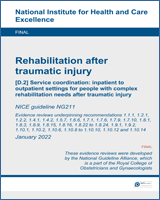|
Bandyopadhyay, S., Wilkinson, I., Giokarinin-Royal, T., How incorporating ‘lean’ approach led to improved delivery of care and reduction in length of hospital stay, Age and Ageing, 48, 2019
| Conference abstract. |
|
Bhowaneedin, A., Smith, H., Deeley, H., Reyes Payeras, C., Keating, O., Smallbone, T., Wright, I., Sharples, P. M., What evidence is available to support the development of a regional specialist neurorehabilitation outreach service, Archives of Disease in Childhood, 104, A26–A27, 2019
| Conference abstract. |
|
Cheung, W. H., Shen, W. Y., Dai, D. L. K., Lee, K. B., Zhu, T. Y., Wong, R. M. Y., Leung, K. S., Evaluation of a multidisciplinary rehabilitation programme for elderly patients with hip fracture: A prospective cohort study, Journal of Rehabilitation Medicine, 50, 285–291, 2018 [PubMed: 29260234]
| Intervention not in PICO: Intervention group included geriatrician care in an acute hospital and a multidisciplinary rehabilitation programme after discharge from the convalescence hospital (rehabilitation service coordination was not in an inpatient setting). |
|
Closa, Conxita, Mas, Miquel A., Santaeugenia, Sebastia J., Inzitari, Marco, Ribera, Aida, Gallofre, Miquel, Hospital-at-home Integrated Care Program for Older Patients With Orthopedic Processes: An Efficient Alternative to Usual Hospital-Based Care, Journal of the American Medical Directors Association, 18, 780–784, 2017 [PubMed: 28578883]
| Comparison not in PICO: Control group are in-patients and the experimental group are out-patients. |
|
Collins, Nina, Miller, Richard, Kapu, April, Martin, Rita, Morton, Melissa, Forrester, Mary, Atkinson, Shelley, Evans, Bethany, Wilkinson, Linda, Outcomes of adding acute care nurse practitioners to a Level I trauma service with the goal of decreased length of stay and improved physician and nursing satisfaction, The journal of trauma and acute care surgery, 76, 353–7, 2014 [PubMed: 24398767]
| Intervention not in PICO: Acute care nurse practitioner (ACPN) who coordinated acute/ clinical care; only mention of “rehabilitation” was “The ACNP attended the daily discharge huddle, a team meeting that encompasses T2 [step-down care from ICU] and T3 [trauma nurse practitioner satellite service] NPs [nurse practitioner], case managers, social worker, liaisons to rehabilitation and nursing home facilities, and home health agency staff to facilitate communication and the discharge process.” Only outcome reported is length of stay. |
|
Cooper, M., Ganda, K., Palmer, A., Seibel, M. J., Cost effectiveness of a targeted intervention to reduce refracture rates: Analysis of a four year prospective controlled study, Journal of Bone and Mineral Research, 26, 2011
| Conference abstract. |
|
Farquhar, M., Lannin, N. A., Morarty, J., Functional outcomes from a specialised acquired brain injury community rehabilitation service - Evaluating a new model of care, Brain Impairment, 18, 344, 2017
| Conference abstract. |
|
Fukuda, Haruhisa, Shimizu, Sayuri, Ishizaki, Tatsuro, Has the Reform of the Japanese Healthcare Provision System Improved the Value in Healthcare? A Cost-Consequence Analysis of Organized Care for Hip Fracture Patients, PLoS ONE, 10, e0133694, 2015 [PubMed: 26208322]
| Comparison not in PICO: Hip fracture care in hospitals autonomously providing integrated care across specialties versus in acute care hospitals and rehabilitative care hospitals providing organized care across separate facilities (the organisation of the care not further described). |
|
Kapu, A., Jones, P., Financial impact of adding acute care nurse practitioners (ACNPs) to inpatient models of care, Critical Care Medicine, 40, 27, 2012
| Conference abstract. |
|
Leung, C. K., Mok, H. W., Shen, W. Y., Cheung, W. H., Leung, K. S., Evaluation of cost-effectiveness of a multidisciplinary hip fracture management program in Hong Kong, Osteoporosis International, 24, S597–S598, 2013
| Conference abstract. |
|
Ling, Shi-Neng James, Kleimeyer, Christopher, Lynch, Genni, Burmeister, Elizabeth, Kennedy, Diana, Bell, Kate, Watkins, Leith, Cooke, Cameron, Can geriatric hip fractures be managed effectively within a level 1 trauma center?, Journal of Orthopaedic Trauma, 29, 160–4, 2015 [PubMed: 25699541]
| Intervention not in PICO: Acute hip fracture care and not coordination of rehabilitation. |
|
Pogoda, Terri K., Levy, Charles E., Helmick, Katherine, Pugh, Mary Jo, Health services and rehabilitation for active duty service members and veterans with mild TBI, Brain Injury, 31, 1220–1234, 2017 [PubMed: 28981342]
| Narrative overview including cost considerations; not an economic evaluation. |
|
Soong, C., Cram, P., Chezar, K., Tajammal, F., Exconde, K., Matelski, J., Sinha, S.K., Abrams, H.B., Fan-Lun, C., Fabbruzzo-Cota, C. and Backstein, D., Impact of an integrated hip fracture inpatient program on length of stay and costs, Journal of orthopaedic trauma, 30, 647–652, 2016 [PubMed: 27875490]
| Population not in PICO: Hip fracture in adults. |
